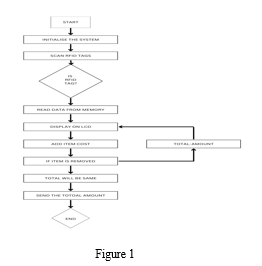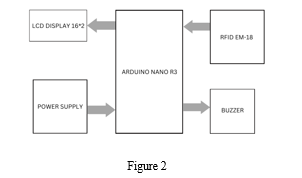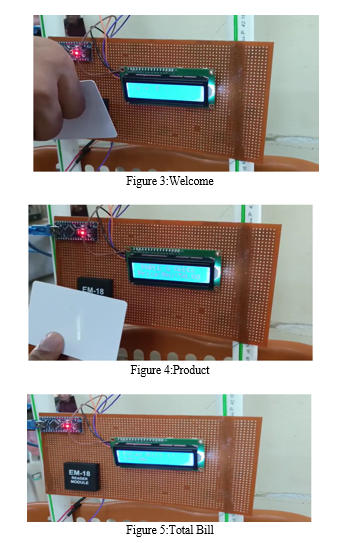Ijraset Journal For Research in Applied Science and Engineering Technology
- Home / Ijraset
- On This Page
- Abstract
- Introduction
- Conclusion
- References
- Copyright
Smart Trolley Using RFID
Authors: Prof. Manisha Mhatre, Omkar Patil, Mohit Patil, Saurabh Patil
DOI Link: https://doi.org/10.22214/ijraset.2023.52968
Certificate: View Certificate
Abstract
People\'s living standards have improved as a result of modern technologies. As a result, there was a large crowd at the mall. To control the huge crowd, we must streamline the billing procedure. A smart shopping system based on RFID is used to accomplish this. Once each item in a smart shopping cart has been read thoroughly, the bill is generated and displayed. after the last A bill is printed. The customer pays the money using the pre-charged cards that the shopping complex has provided. The objective is to reduce time consumption. It makes use of RFID technology, which can scan a large number of things and help save both customers\' and the mall\'s valuable time.
Introduction
I. INTRODUCTION
Shopping at large malls and hyper cities is presently becoming a daily activity in major cities, according to the current situation. As a result, malls had heavy traffic throughout weekends and holidays. After paying for the item at the billing counter, the cashier prepares the bill by scanning the item's barcode, which takes time. As a result, long lines are common in the mall, and shoplifting has recently increased as a result, causing a significant financial loss for the establishment. Shopping centres are becoming more congested and malls are experiencing heavy traffic due to the expanding population in cities. Customers must therefore wait in a lengthy queue for billing and when there is not enough staff for billing. Our team developed a smart shopping cart to address these problems.
To do this, simply equip the shopping cart with an RFID reader with an LCD and RFID tags for the products. With the help of RFID and an LCD, the consumer will need to be aware of the price of each item that is scanned into the system; the LCD will display the item's entire cost. This method will save mall patrons' time and lessen the labour force requirements. It is frequently used in shopping centres to lighten the staff's workload.
II. LITERATURE REVIEW
- This paper addresses the growing interest among organizations in implementing RFID systems as a means to enhance their competitiveness. It recognizes the managerial challenges involved in planning and implementing such systems and highlights the potential for wasted efforts and failed implementations. To overcome these challenges, the paper presents a systematic and comprehensive RFID implementation framework. This framework has been validated by both users and experts, providing a reliable guide for organizations undertaking RFID projects. The framework outlines the crucial tasks to be accomplished at each step of the implementation process, allowing practitioners to make informed decisions regarding the feasibility and progress of the project. Additionally, the paper discusses essential considerations for implementation and emphasizes the critical success factors necessary for the successful deployment of RFID systems.
- This research proposes an innovative RFID-enabled smart trolley system aimed at facilitating users during their shopping experience. The system offers multiple benefits, including the ability for users to quickly locate items without seeking assistance, providing real-time information on the amount of goods purchased, and enabling customers to have better control over their financial budget while shopping. The primary objective of this study is to evaluate the user feedback on the implementation of the smart trolley system with innovative RFID technology. The research scope covers staff, customers, and suppliers in Giant Hypermarket, located in Bandar Seri Manjung, Perak. A total of 250 questionnaires were distributed to gather feedback, with 200 questionnaires collected from customers, staff, and suppliers. The research focuses on three key elements: spending time, budget control, and product layout, which serve as indicators to assess the significance of the smart trolley implementation. The results indicate that budget control received the highest feedback from customers, as the smart trolley assists in managing expenses, thereby enhancing the flow of their finances.
- A suggestion was presented to create a product that would help someone in their daily search by shortening the time spent making a purchase. The primary purpose of the suggested system is to offer a cutting-edge technologically affordable scalable and long-lasting system that enables in-person shopping.
- A cart containing a product identifying device (PID) which has an LCD, a reader for RFID, a EEPROM, plus a ZigBee module was proposed as a solution. To read the information about the purchased products, an RFID reader would be used. The product information will be temporarily saved in the basket. This has a connected EEPROM, and using the ZigBee module, the data via this EEPROM will be sent to the primary system for billing. The centralized billing system accesses the product database, retrieves the EEPROM and cart data, and computes the total sum of purchases of that specific trolley.
III. METHODOLOGY/EXPERIMENTAL
A. Materials
The methodology for implementing the smart trolley system using RFID technology involves several key steps and components. Firstly, RFID tags are integrated with product items, where each tag contains essential information such as the product name, price, and expiry date. These tags are strategically placed on the products to ensure accurate detection and reading during the shopping process. The communication between the RFID readers and the microcontroller unit is established through a specific protocol. RFID readers are selected based on their compatibility and performance requirements. The readers transmit the data captured from the RFID tags to the microcontroller unit, which acts as the central processing unit of the system. The microcontroller unit processes the received data by retrieving product details from the database server. This involves querying the database using the information obtained from the RFID tags, such as the unique product identifier. Additionally, real-time stock tracking algorithms may be implemented to ensure accurate inventory management. The microcontroller unit also performs billing calculations based on the detected products and their corresponding prices. Each component used in the system undergoes a detailed analysis. RFID tags are evaluated based on their technical specifications, such as frequency range, read range, and memory capacity. RFID readers are selected and analyzed based on factors like communication protocols, read speed, and compatibility with the microcontroller unit. The microcontroller unit is chosen considering its processing power, memory capacity, and support for interfacing with the database server. The database server is selected based on its ability to handle large amounts of data and provide fast response times. The proposed methodology is validated through an experimental setup. Hardware and software configurations are established, and the system is tested in a controlled environment. Performance metrics such as accuracy, response time, and usability are measured and analyzed. Any limitations or challenges encountered during the experimentation are also discussed. The results obtained from the experiments provide insights into the effectiveness and feasibility of the smart trolley system using RFID technology. In conclusion, the methodology for the smart trolley system using RFID technology involves integrating RFID tags with products, establishing communication between RFID readers and the microcontroller unit, processing data, and conducting a component analysis. The experimental setup validates the proposed methodology and provides valuable insights into the system's performance and usability.
B. Flowchart

A flowchart for a smart trolley system using RFID can help visualize the sequence of steps involved in the system's operation. Here's an explanation of a basic flowchart for such a system:
- Start: The flowchart begins with the start symbol, representing the initiation of the smart trolley system.
- Initialize System: This step involves initializing all the system components, including RFID readers, the microcontroller unit, and the database server.
- Scan RFID Tag: The system waits for the RFID reader to detect an RFID tag placed on a product item. Once a tag is detected, the system proceeds to the next step.
- Read Tag Data: The RFID reader reads the data encoded in the RFID tag, such as the unique product identifier.
- Retrieve Product Information: Using the read tag data, the system queries the database server to retrieve the corresponding product information, such as the product name, price, and expiry date.
- Display Product Information: The retrieved product information is displayed to the user, providing real-time details about the scanned product.
- Add Product to Trolley: The user has the option to add the scanned product to their shopping trolley. If selected, the system adds the product to the trolley and updates the total bill.
- Check for Additional Scans: The system checks if there are more products to be scanned. If yes, it returns to the RFID tag scanning step (Step 3). If no, it proceeds to the next step.
- Display Final Bill: Once all the desired products have been scanned and added to the trolley, the system displays the final bill to the user, reflecting the total cost of the selected items.
- End: The flowchart ends, representing the completion of the smart trolley system operation.
C. Block Diagram

The system block diagram for the smart trolley using RFID comprises essential components such as the power supply, Arduino Nano, EM 18 Module (RFID), buzzer, and LCD display. The power supply ensures the proper electrical power distribution to all components of the system. The Arduino Nano acts as the central processing unit, receiving and processing data from the RFID reader. The EM 18 Module serves as the RFID reader, emitting radio waves to read the unique identification data stored on the RFID tags attached to the products. When an RFID tag is successfully read, the Arduino Nano triggers the buzzer to produce an audible signal. Simultaneously, it controls the LCD display, presenting the retrieved product details, including the name, price, and other relevant information. This system architecture enables seamless data processing and real-time information display, enhancing the shopping experience for users of the smart trolley.
D. Design
- The Smart Trolley ought to be simple to transport.
- Security tracking devices should be installed on each smart trolley to prevent anyone from removing them from retail locations.
- It has to have an Arduino system placed on a PCB board.
- The cart should be made with all four wheels, a brake with steering that is simple to use.
- Required power supply to all attached devices.
IV. RESULTS AND DISCUSSIONS
All of the experimental components were covered above, and the suggested system's LCD is utilized to show the cost of the product. The suggested model is simple to use, doesn't need specific training, and is readily available. The user will spend less time in the billing queue thanks to the reduction in staff. The ability to service multiple users at once benefits both customers and retailers. This intelligent billing solution guarantees both time and financial efficiency. The smart trolley attempts to speed up the billing process. By letting consumers create a shopping session that lasts until the customer requests it be automatically cleared as well as storing the data of each item in the basket by using RFID tags in order to make data entry easier. By showing the buyer the whole price, it also helps them stay inside their budget when purchasing. As online shopping becomes more popular and less of a hassle, stores are introducing eco-friendly smart carts as well as smart baskets that not only help them reduce crowds but also cut down on the amount of paper used, employees needed, and money that would otherwise be wasted printing duplicates of bills. The usage of RFID technology-based smart carts is therefore very critical or crucial. The results of customers' shopping are displayed on Liquid Crystal Displays in terms of price, item name, and occasionally a warning that a product is no longer in stock. The procedure proceeds as when items are added and the sum of items is cumulative in action as the RFID Reader scans the products from RFID tags and displays the item name and cost.

V. ACKNOWLEDGMENT
Guidance throughout the project and researching was provided by Prof. M. Mhatre. Our sincere gratitude to HOD Instrumentation department and VIT Pune Instrumentation department for this opportunity.
Conclusion
The EM-18 reader, an Arduino, and RFID technology were used to complete the task. Its objective is to reduce the amount of time spent waiting in long lines for billing so that customers gain, and handling inventory is made easier. Whenever there is a hurry to get inside a store as there is plenty of foot traffic, it might be employed at shopping malls. This intelligent tram system has a significant impact. on the development of technology in the field of automation. This technology will replace the barcode system that is currently in use. As a result, this sort of equipment has been used to shorten queues and lines at billing counters, facilitating quick transaction completion for customers.
References
[1] RFID JOURNAL, 2002-2007, REFFERD 6.8.2007, http://www.rfidjournal.com [2] https://www.researchgate.net/publication/322537108_A_SMART_TROLLEY_WITH_RFID_IMPLEMENTATION_A_SURVEY_AMONG_CUSTOMERS [3] Shankar,S. K., Balasubramani, S., Basha, S. A., Ariz Ahamed S., Kumar Reddy, N. S. 2021. Smart Trolley for Smart Shopping with an Advance Billing System using IoT, 5th International Conference on Computing Methodologies and Communication. [4] Pavni Swaroop, AkshitaParasari, Mansi Singh, Shobha Rajput, 2020. A Review paper on Smart Trolley System forAutomated Billing using RFID and IoT, International Journal of Creative Research Thoughts (IJCRT), 8(7) 2978-2982.
Copyright
Copyright © 2023 Prof. Manisha Mhatre, Omkar Patil, Mohit Patil, Saurabh Patil. This is an open access article distributed under the Creative Commons Attribution License, which permits unrestricted use, distribution, and reproduction in any medium, provided the original work is properly cited.

Download Paper
Paper Id : IJRASET52968
Publish Date : 2023-05-25
ISSN : 2321-9653
Publisher Name : IJRASET
DOI Link : Click Here
 Submit Paper Online
Submit Paper Online

